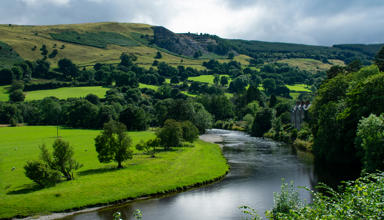Why is tree planting on the agenda?
The then Welsh Government published the first Woodlands for Wales strategy in 2001. It focused on woodland management, services and jobs. An updated strategy in 2009 expanded this to consider the role of trees outside woodland, and the role of trees and woodland in storing carbon and mitigating the effects of climate change.
In its current Woodlands for Wales strategy, the Welsh Government sees woodlands and trees as vital in:
… sustaining the wider environment, providing opportunities for people and communities and in improving the lives of everyone in Wales.
Tree planting also forms part of the Welsh Government’s Net Zero Wales plan, as trees, hedges and peatland can remove greenhouse gases from the atmosphere by capturing and storing carbon in biomass and soil.
The Welsh Government Woodland Estate (WGWE), managed by Natural Resources Wales (NRW), also aims to support delivery of Woodlands for Wales. Through managing the WGWE, NRW aims to, amongst other things, increase timber supply, protect intact woodland, and increase tree-planting for net-zero.
Tree planting can sometimes prove controversial and the mantra of "the right tree in the right place" is often used in Wales.
NFU Cymru has expressed concerns that planting trees on productive agricultural land can reduce both business viability and food security.
There has also been unease in rural communities about large corporations outcompeting local families to buy farms to plant trees for carbon offsetting.
This debate over land use continues, with the Confederation of Forest Industries (Confor) saying that conservationists, farmers and foresters are “all competing over the land mass of Wales” and that “and that there is a need to work together”.
Tree planting progress to date
Figure 1 – Total new planting in Wales, 1971 to 2025

Source: Forest Research
Woodland in Wales currently covers 313,000 hectares (ha), an area that has stayed roughly the same since 2005. The initial planting target was set in 2009, and then increased significantly in 2010 (Table 1).
Table 1 – Welsh Government tree planting targets
|
Welsh Government tree planting target (hectares per year eq) |
Year set |
Year by |
Strategy |
|
500 |
2009 |
2012 |
Woodlands for Wales |
|
5,000 |
2010 |
2030 |
Climate Change Strategy for wales |
|
4,300 |
2021 |
2030 |
Written Statement: Trees and Timber |
Source: Woodlands for Wales, Climate Change Strategy for Wales, Written Statement: Trees and Timber
Despite these ambitious targets, the average planting rate between 2010 and 2020 was 430 ha per year, and in 2020 it was just 80 ha, well below the target.
In 2021, the Welsh Government changed the target again to 43,000 ha by 2030, to meet the ‘balanced pathway’ to a Net Zero Wales suggested by the UK Climate Change Committee (UKCCC) in 2020. As of 2024, only 12% of this target had been hit.
Figure 2 – Welsh Government actions on tree planting, with new tree planting levels, 1999-2025

Source: Forest Research, Woodlands for Wales, Climate Change Strategy for Wales, Written Statement: Trees and Timber, UKCCC
Welsh tree planting rates falling short of the target has been an issue for well over a decade. In 2017, a Senedd Committee found:
There is a massive gap between aspiration and reality, and fundamental change in the approach to woodland creation in Wales is needed. […] The Welsh Government must lead by example and increase afforestation on public land.
The most recent (2025) tree planting target suggested by the UKCCC is a less ambitious 22,000 ha of woodland planted by 2030 (compared to 2020) as part of the updated balanced pathway ambition. However, the suggested 2050 target has increased from 180,000 ha to 208,000 ha, which would need a significantly larger mobilisation of tree planting across Wales to achieve.
Figure 3 – Actual and projected cumulative tree planting, 2020 to 2050

Source: Welsh Government, Forest Research, UKCCC
Trees and Timber Deep Dive
In 2021, the Welsh Government conducted a deep dive into trees and timber. The aim was to develop actions to increase tree planting, and overcome barriers to:
- woodland creation;
- the use of Welsh timber in construction; and,
- encouraging community tree planting.
The deep dive’s Trees and Timber Task Force recommended changes to the then proposed Sustainable Farming Scheme, actions on outreach and funding to encourage tree planting, and the design of the Timber Industrial Strategy (a strategy led by the Welsh Government to increase timber supply and create more jobs in the forestry industry).
Recommendations released after the deep dive by the Woodland Finance Working Group and in the Woodland Creation in Wales report mentioned the need for clearer guidance on how Wales should meet existing planting targets. They called for more information on the expected levels of planting each year, and the types of woodland and stakeholders that would be involved.
The deep dive also highlighted the need for increased funding for restocking and new planting. There are several woodland grants currently available from the Welsh Government, for example, the Woodland Creation Grants, Coetiroedd Bach (Tiny Forests), and the Woodland Investment Grant (TWIG).
Funding available through TWIG is part of the National Forest for Wales programme led by the Welsh Government, which aims to create a network of woodlands and forests throughout Wales.
The Sustainable Farming Scheme
The Welsh Government aimed to increase tree planting through a mandatory 10% tree cover rule on farms participating in the Sustainable Farming Scheme (SFS).
This proposal led to widespread debate, with environmental organisations, for example Coed Cadw, praising the attempt at increasing tree planting, but many farmers worrying for potential losses in farming jobs and income. The high-profile debate led to scrutiny of the draft SFS by two Senedd Committees in early 2024 (Economy, Trade and Rural Affairs and Climate Change, Environment and Infrastructure)
In November 2024, the SFS Carbon Sequestration Evidence Review Panel concluded that mandatory tree cover was likely to prevent farmers joining the scheme.
The Welsh Government removed the 10% tree planting requirement and replaced it with a new ‘Universal Action’ requiring participating farmers to produce a “tree planting and hedgerow creation opportunity plan”. Farmers will have to show progress towards their opportunity plan by the end of 2028, with the Welsh Government asking each farm to plant at least 0.1 ha of trees by this time.
Through the SFS, the Welsh Government is committing to achieve at least 17,000 ha of new tree planting across Wales by 2030. However, this is still less than the current Welsh Government (43,000 ha) or UKCCC suggested (22,000 ha) tree planting targets, meaning further action will be needed beyond the SFS to achieve the targets set.
What’s next?
Whilst progress has been made with policies and schemes to increase new tree planting in Wales, levels of actual planting and cooperation across multiple sectors need to rise to meet the current 2030 targets. As well as this, the Welsh Government must publish its plan towards achieving Carbon Budget 3 before the end of 2026, and tree planting could make up a part of the strategy.
Article by Liesl van de Vyver Blackman, Senedd Research, Welsh Parliament
Senedd Research acknowledges the parliamentary fellowship provided to Liesl van de Vyver Blackman by the Natural Environment Research Council (NERC) which enabled this guide to be completed.






